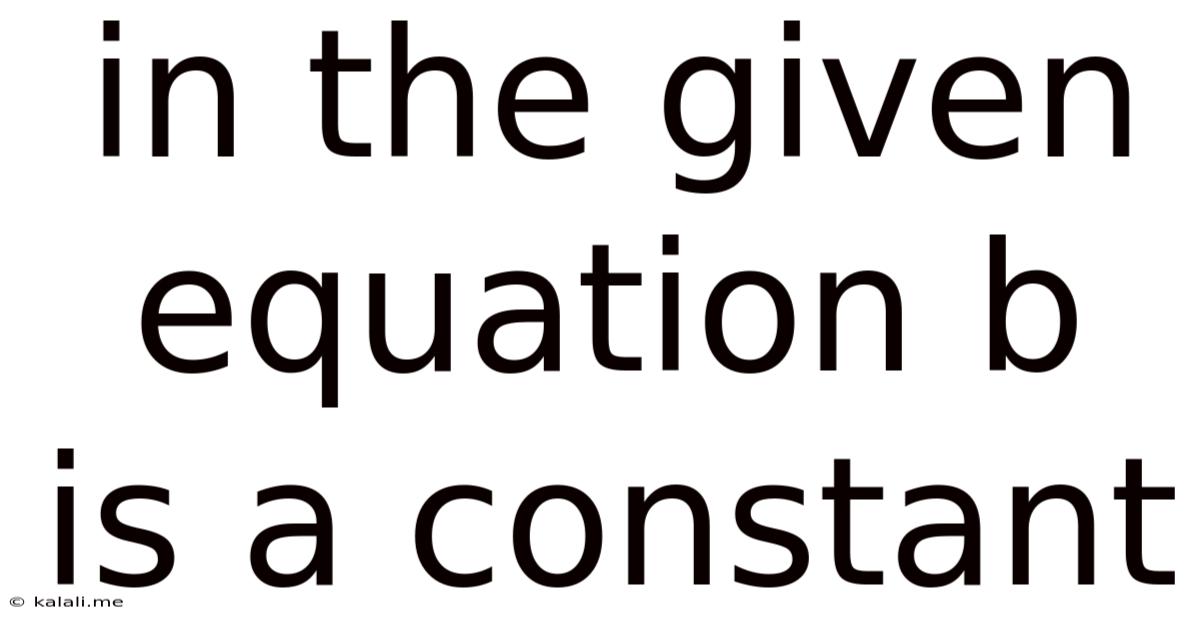In The Given Equation B Is A Constant
Kalali
Jun 13, 2025 · 3 min read

Table of Contents
Solving Equations with a Constant: A Comprehensive Guide
Meta Description: This article provides a comprehensive guide to solving equations where 'b' represents a constant, covering various equation types and offering step-by-step solutions and examples. Learn how to isolate variables and find solutions effectively.
Understanding how to solve equations containing constants is a fundamental skill in algebra and beyond. A constant, often represented by a letter like 'b', is a value that remains unchanged throughout the equation. This guide will walk you through various scenarios, providing clear explanations and examples to help you master this crucial mathematical concept.
Types of Equations with Constants
Equations containing constants can take many forms, from simple linear equations to more complex polynomial equations. Here are a few common types:
-
Linear Equations: These equations have a variable raised to the power of 1 (e.g.,
ax + b = c). Solving these often involves isolating the variable 'x' through addition, subtraction, multiplication, and division. -
Quadratic Equations: These equations involve a variable raised to the power of 2 (e.g.,
ax² + bx + c = 0). Solving quadratic equations often requires factoring, using the quadratic formula, or completing the square. The constant 'b' in this case plays a critical role in determining the roots or solutions of the equation. -
Exponential Equations: These equations involve variables as exponents (e.g.,
abˣ = c). Solving these often requires using logarithms. The constant 'b' acts as the base of the exponential function.
Step-by-Step Solution Strategies
The approach to solving equations with a constant 'b' depends largely on the type of equation. However, several general strategies apply:
-
Simplify the Equation: Combine like terms and simplify the equation as much as possible before attempting to isolate the variable. This often involves applying the order of operations (PEMDAS/BODMAS).
-
Isolate the Variable: Use inverse operations to move all terms without the variable to one side of the equation, leaving the variable term isolated on the other side. Remember that whatever operation you perform on one side of the equation must be performed on the other to maintain equality.
-
Solve for the Variable: Once the variable is isolated, perform the necessary operations to solve for its value. This often involves division or taking the root.
-
Check your Solution: Substitute the obtained value back into the original equation to verify that it satisfies the equation. This step is crucial to ensure accuracy.
Examples
Let's look at some examples illustrating these strategies:
Example 1: Linear Equation
Solve for x: 3x + b = 12
- Subtract 'b' from both sides:
3x = 12 - b - Divide both sides by 3:
x = (12 - b) / 3
Therefore, the solution for x is dependent on the value of the constant 'b'.
Example 2: Quadratic Equation
Solve for x: x² + bx - 6 = 0 (assuming this factors easily)
This equation might factor into something like (x + 3)(x - 2) = 0 (This depends on the value of b; it would require a specific value of b to factor like this.) If that were the case, the solutions would be x = -3 and x = 2. Finding the correct value of 'b' would involve expanding and comparing coefficients. More generally, the quadratic formula should be used to find solutions for all values of 'b'.
Example 3: Exponential Equation
Solve for x: 2ˣ = b
- Take the logarithm of both sides:
log(2ˣ) = log(b) - Use the logarithm power rule:
x log(2) = log(b) - Solve for x:
x = log(b) / log(2)
Conclusion
Solving equations with a constant 'b' requires a systematic approach and understanding of different equation types. By following the steps outlined above and practicing with various examples, you will develop the necessary skills to confidently solve a wide range of equations, regardless of the constant's value. Remember that the constant's presence doesn't change the fundamental principles of solving equations; it simply adds another element to consider within the context of the problem.
Latest Posts
Latest Posts
-
Four Letter Word With Second Letter A
Jul 01, 2025
-
How Many 1 8 Cups Are In 2 3 Cup
Jul 01, 2025
-
How Many Slices Of Turkey In 2 Oz
Jul 01, 2025
-
Omnipoint Miami E License Llc Miami Fl
Jul 01, 2025
-
Mi Familia Fuera La M S Grande Correct Incorrect
Jul 01, 2025
Related Post
Thank you for visiting our website which covers about In The Given Equation B Is A Constant . We hope the information provided has been useful to you. Feel free to contact us if you have any questions or need further assistance. See you next time and don't miss to bookmark.